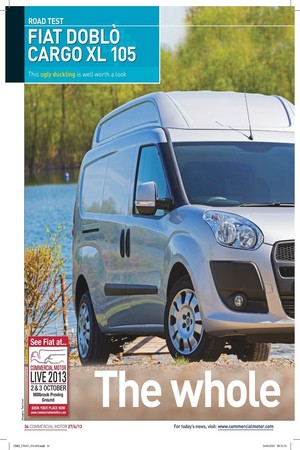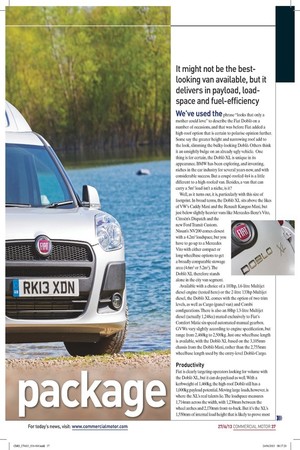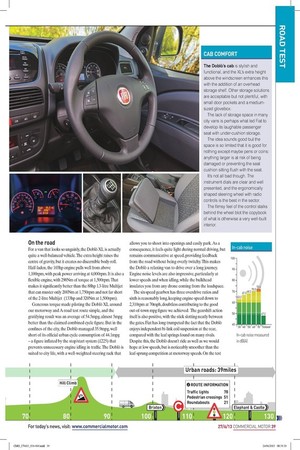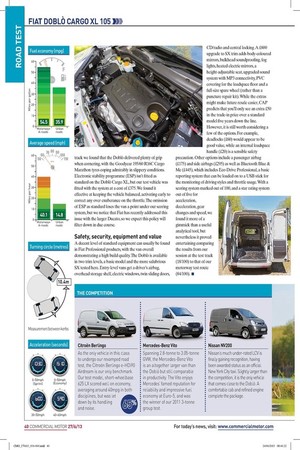ackage We've used the phrase "looks that only a mother
Page 28

Page 29

Page 31

Page 32

If you've noticed an error in this article please click here to report it so we can fix it.
could love" to describe the Fiat DoblO on a number of occasions, and that was before Fiat added a high-roof option that is certain to polarise opinion further. Some say the greater height and narrowing roof add to the look, slimming the bulky-looking DoblO. Others think it an unsightly bulge on an already ugly vehicle. One thing is for certain, the DoblO XL is unique in its appearance. BMW has been exploring, and inventing, niches in the car industry for several years now, and with considerable success. But a coupe-roofed 4x4 is a little different to a high-roofed van. Besides, a van that can carry a 5m3 load isn't a niche, is it?
DoblO XL therefore stands area (4.6m' or 5.210. The alone in the city van segment.
Available with a choice of a 103hp, 1.6-litre Multijet diesel engine (tested here) or the 2-litre 133hp Multijet diesel, the DoblO XL comes with the option of two trim levels, as well as Cargo (panel van) and Combi configurations. There is also an 88hp 1.3-litre Multijet diesel (actually 1,248cc) mated exclusively to Fiat's Comfort Matic six-speed automated manual gearbox. GVVVs vary slightly according to engine specification, but range from 2,460kg to 2,500kg. Just one wheelbase length is available, with the DoblO XL based on the 3,105mm chassis from the DoblO Maxi, rather than the 2,755mm wheelbase length used by the entry-level DoblO Cargo.
Productivity Fiat is clearly targeting operators looking for volume with the DoblO XL, but it can do payload as well. With a kerbweight of 1,460kg, the high-roof DoblO still has a 1,000kg payload potential. Moving large loads, however, is where the XL's real talents lie. The loadspace measures 1,714mm across the width, with 1,230mm between the wheel arches and 2,170mm front-to-back. But it's the XL's 1,550mm of internal load height that is likely to prove most On the road For a van that looks so ungainly, the Doblo XL is actually quite a well-balanced vehicle. The extra height raises the centre of gravity, but it creates no discernible body-roll. Half-laden, the 103hp engine pulls well from above 1,100rpm, with peak power arriving at 4,000rpm. It is also a flexible engine, with 290Nm of torque at 1,500rpm. That makes it significantly better than the 88hp 1.3-litre Multijet that can muster only 200Nm at 1,750rpm and not far short of the 2-litre Multijet (133hp and 320Nm at 1,500rpm).
Generous torque made piloting the Doblo XL around our motorway and A-road test route simple, and the gratifying result was an average of 54.5mpg, almost 5mpg better than the claimed combined cycle figure. But in the confines of the city, the Doblo managed 35.9mpg, well short of its official urban cycle consumption of 44.1mpg — a figure inflated by the stop/start system (£225) that prevents unnecessary engine idling in traffic. The Doblo is suited to city life, with a well-weighted steering rack that allows you to shoot into openings and easily park. As a consequence, it feels quite light during normal driving, but remains communicative at speed, providing feedback from the road without being overly twitchy. This makes the Doblo a relaxing van to drive over a long journey. Engine noise levels are also impressive, particularly at lower speeds and when idling, while the bulkhead insulates you from any drone coming from the loadspace.
The six-speed gearbox has three overdrive ratios and sixth is reasonably long, keeping engine-speed down to 2,310rpm at 70mph, doubtless contributing to the good out-of-town mpg figure we achieved. The gearshift action itself is also positive, with the stick slotting neatly between the gates. Fiat has long trumpeted the fact that the Doblo enjoys independent bi-link coil suspension at the rear, compared with the leaf springs found on many rivals. Despite this, the Doblo doesn't ride as well as we would hope at low speeds, but is noticeably smoother than the leaf-sprung competition at motorway speeds. On the test track we found that the DoblO delivered plenty of grip when cornering, with the Goodyear 195/60 R16C Cargo Marathon tyres coping admirably in slippery conditions. Electronic stability programme (ESP) isn't fitted as standard on the DoblO Cargo XL, but our test vehicle was fitted with the system at a cost of £375.We found it effective at keeping the vehicle balanced, activating early to correct any over exuberance on the throttle. The omission of ESP as standard loses the van a point under our scoring system, but we notice that Fiat has recently addressed this issue with the larger Ducat°, so we expect this policy will filter down in due course.
Safety, security, equipment and value A decent level of standard equipment can usually be found in Fiat Professional products, with the van overall demonstrating a high build quality. The DoblO is available in two trim levels, a basic model and the more salubrious SX tested here. Entry-level vans get a driver's airbag, overhead storage shelf, electric windows, twin sliding doors,








































